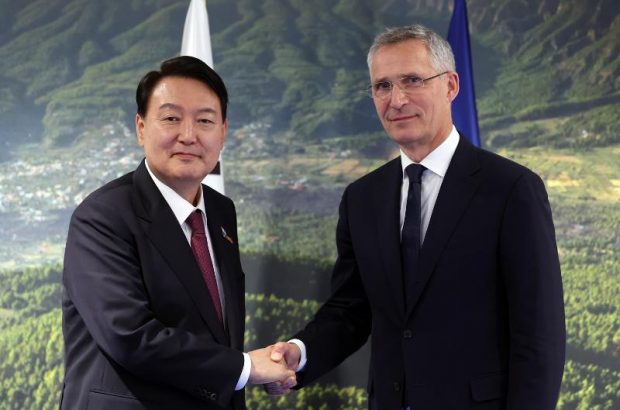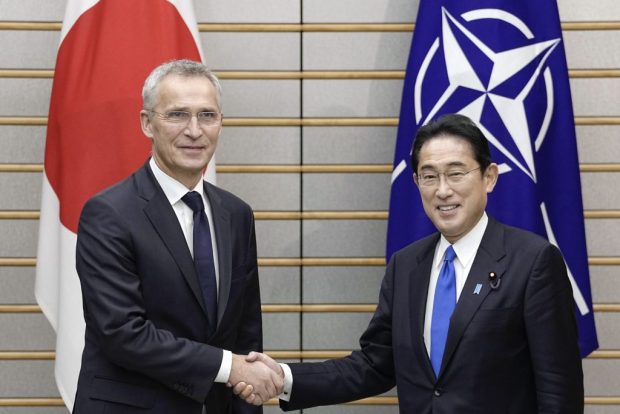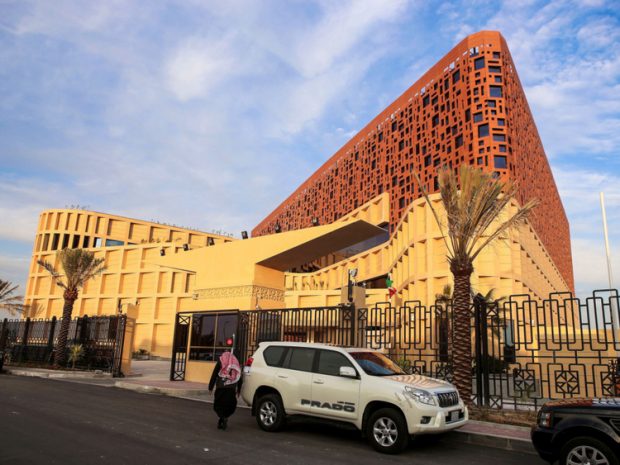NATO and its partners: An inevitable global security architecture?
 Korea’s President Yoon Suk Yeol shakes hands with NATO Secretary General Jens Stoltenberg (Yonhap)
Korea’s President Yoon Suk Yeol shakes hands with NATO Secretary General Jens Stoltenberg (Yonhap)
By Habib Toumi
SEOUL: Amid the recent moves by the North Atlantic Treaty Organization (NATO) to create a series of overlapping and distinctive multilateral and mini-lateral alliances beyond its initial geographical limits, reactions across the globe have been vastly different, ranging from enthusiastic support to vitriolic attacks.
The alliance started with 12 member countries in 1949 as a collective defense mechanism for North America and war-torn Europe during the Cold War. Today, with Finland joining and Sweden waiting, it has 31 members.
NATO was initially structured to counter-balance the military might of the former Soviet Union.
According to NATO, the alliance “provides a unique link between these two continents, enabling them to consult and cooperate in the field of defense and security, and conduct multinational crisis-management operations together.”
NATO says that its purpose is to “guarantee the freedom and security of its members through political and military means.”
Politically, NATO says it “promotes democratic values and enables members to consult and cooperate on defense and security-related issues to solve problems, build trust and, in the long run, prevent conflict.”
Militarily, NATO says it is committed to the peaceful resolution of disputes.
“If diplomatic efforts fail, it has the military power to undertake crisis-management operations. These are carried out under the collective defense clause of NATO’s founding treaty – Article 5 of the Washington Treaty or under a United Nations mandate, alone or in cooperation with other countries and international organizations.” So far, Article 5 has been invoked once – in response to the 9/11 terrorist attacks in the United States in September 2001.
NATO’s 2022 Strategic Concept affirms that NATO’s key purpose is “to ensure the collective defense of its members, based on a 360-degree approach, and outlines three core tasks – deterrence and defense, crisis prevention and management, and cooperative security.”
The alliance says that NATO membership is open to “any other European state in a position to further the principles of this Treaty and to contribute to the security of the North Atlantic area.”

Japanese Prime Minister Fumio Kishida with NATO Secretary General Jens Stoltenberg
However, NATO has also worked with many non-member countries and built several partnerships and deals with international organizations across the world to address a wide range of political and security-related issues.
In the Euro-Atlantic area, the alliance has engaged in relations with 19 partner countries through the Euro-Atlantic Partnership Council and the Partnership for Peace.
NATO has also developed relations with the seven countries on the southern Mediterranean rim through the Mediterranean Dialogue (MD), and with four of the six Gulf Cooperation Council (GCC) countries through the Istanbul Cooperation Initiative (ICI).
Outside these regional partnership frameworks, NATO is cooperating with a range of countries, referred to as “partners across the globe,” that include Afghanistan1, Australia, Colombia, Iraq, Japan, the Republic of Korea, Mongolia, New Zealand and Pakistan.
The alliance has also made its way into the Asia-Pacific region and reinforced its relations with South Korea and Japan that were, in an unprecedented move, invited to attend the NATO 2022 summit in Madrid, provoking both optimism and concern about the alliance’s growing role in Asia.
NATO is often well received in the MD and ICI regions where it has been seen as a potent ally and set up a liaison office in Kuwait for the ICI countries.
Officials in the MD and ICI countries often commend their special ties with NATO, mainly in the Gulf, one of the most volatile regions in the world.
UAE Foreign Minister Shaikh Abdullah bin Zayed Al Nahyan has stressed that “relations between the countries of the region and NATO should not be only viewed between a region and an alliance.”
“There is also a strategic relationship between our countries and the Alliance. And all of those have been strengthened by the ICI,” he said.
“At the same time, we have to know that we are living in a changing world. A world in which you have friends and enemies. And those enemies are not necessarily countries or institutions. At the same time our efforts must be increased in order to stabilize the region.”
The Gulf area was and still is and will remain an important area for peace and for international stability, he said.
“And we do believe that the Gulf area because of its vivacity has a role to play, it has a mission. Our countries have a mission. But the international community also has a mission, and the great powers and NATO have a mission as well. We must cooperate to preserve, maintain and improve this area.”
For the minister, the UAE partnership with NATO allows his country to develop its capacities and knowledge and helps it to undertake some of the tasks such as the UAE mission in Afghanistan.
In Asia where widely receptive South Korea and Japan are hailing a more visible presence of NATO in the region, with Tokyo reportedly offering to host a NATO office, there has been concern that the alliance is “extending its tentacles to the Asia-Pacific.”
NATO that has regularly emphasized its role as a defensive regional alliance, might, through its presence in Asia, make a shift in its core defense nature, several critics have said.
As NATO is building and cementing partnerships with Asian countries, the critics have deepened a negative perception of the alliance and argued that it has no role or business in Asia and should confine itself to its initial geographical confines.
However, NATO has rejected the claims and stressed that it needed to maintain robust partnerships in the region to deal with new ominous threats and menacing challenges.
in its “NATO 2030: United for a New Era” report that defines the alliance’s vision for the next decade, NATO said that “the simultaneous geopolitical and ideological challenge from Russia and China, portends consequences for the security and prosperity of us all.”
The report said that “China is increasingly likely to project military power globally, including potentially in the Euro-Atlantic area. China’s industrial policy and military-civil fusion (MCF) strategy are central components of this systemic challenge.”

NATO liaison office in Kuwait
For NATO, this means the obligation to be ready to “meet the needs of a more demanding strategic environment marked by the return of systemic rivalry, persistently aggressive Russia, and the rise of China” and “to develop a political strategy for approaching a world in which China will be of growing importance through to 2030.”
In November 2020, NATO Secretary General Jens Stoltenberg stressed that “China is not our adversary” and that “its rise presents an important opportunity for our economies and trade.”
However, he noted that “there are also important challenges to our security. China is investing massively in new weapons. It is coming closer to us, from the Arctic to Africa, and by investing in our infrastructure.”
Last month, Stoltenberg said that “NATO will remain an alliance of North America and Europe, but as a defensive Alliance we see strong value in strengthening the partnership with our Indo-Pacific partners.”
He said that the alliance faces “global threats and challenges, everything from cyber to terrorism, but also, of course, the security consequences of the rise of China, where China is investing heavily in new modern military capabilities. We see that threatening neighbors and we see also China’s coming closer to us.”
“That is the reason why we, in our Strategic Concept, state clearly that China is a challenge to our values, to our security, and to our interests. That’s also why we have decided to further strengthen our partnership with our Indo-Pacific partners: Japan, South Korea, New Zealand and Australia. I invited the leaders of these countries to come to Vilnius and we appreciate very much to strengthen the partnership with them. NATO will remain the Alliance of North America and Europe, but as a defensive Alliance we see strong value in strengthening the partnership with our Indo-Pacific partners.”
In an indication of how NATO is viewing developments in China’s growing role in recent years, the alliance’s 2022 Strategic Concept mentioned China only once.
As events unfold, NATO still faces a hard time achieving a truly unified response to China’s rise as attitudes and approaches within the 31-member alliance toward the Asian giant vary widely while Beijing maintains that it “has never practiced anything like coercive diplomacy or intimidating diplomacy.”
NATO’s partners
Euro-Atlantic Partnership Council (EAPC)
Armenia, Austria, Azerbaijan, Belarus1, Bosnia and Herzegovina, Georgia, Ireland, Kazakhstan, Kyrgyzstan, Malta, Moldova, Russia (suspended), Serbia, Sweden, Switzerland, Tajikistan, Turkmenistan, Ukraine, Uzbekistan
NATO’s Mediterranean Dialogue
Algeria, Egypt, Israel, Jordan, Mauritania, Morocco, Tunisia
Istanbul Cooperation Initiative (ICI)
Bahrain, Kuwait , Qatar, United Arab Emirates
Partners across the globe
Afghanistan, Australia, Colombia, Iraq, Japan, Republic of Korea, Mongolia, New Zealand, Pakistan
International organizations
United Nations (UN), European Union (EU) and Organization for Security and Co-operation in Europe





















































